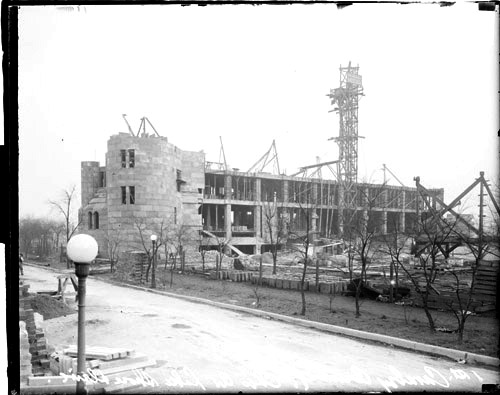
Courtesy of the Chicago History Museum.
On May 11, 1915, Governor Edward F. Dunne wrote a letter to the Lincoln Park Commissioners proposing a land swap: "In view of the fact that both pieces are to be held for public use and it is to be a mere exchange between public corporate bodies, I think that such an exchange should be made at once. Deeds should be made out and executed and the National Guard allowed to take possession of the Chicago Avenue property, leaving the matter of the difference in values to be adjusted, if necessary, in the future." Once more, as with the two previously chosen locations, there were objections. The land exchange was eventually completed and construction commenced in May 1916. (Seventy years later, in another land swap, the National Guard would remove to new location, allowing the Museum of Contemporary Art Chicago to occupy the grounds.)
The Economist, Vol. 55, p. 1076
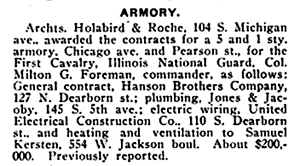
|
Chicago Daily Tribune, May 30, 1915
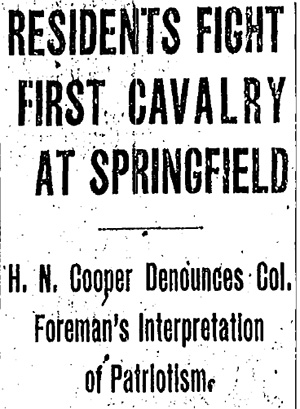
Once more the proposed site of the First Cavalry armory has precipitated a fight between adjoining property owners and officers of the cavalry. This time the site suggested at the foot of Chicago avenue is objected to by several dozen property owners living in the exclusive residential section immediately to the north.
They will be on hand to denounce the proposed site when the matter is thrashed out before a subcommittee of the legislature tomorrow. Col. Milton J. Foreman asserted yesterday that the cavalry is tired of being shunted to and fro at the protest of property owners, and that if the armory is not built on the park property suggested it will mean the end of the regiment.
Threatens Legal Action.
This assertion was ridiculed by H.N. Cooper, spokesman for the residents. He added that if the legislature approves the site, legal steps will be taken to prevent the construction of the building.
“Citizens interested in parks and playgrounds will not abandon their opposition to giving any part of the grounds dedicated and used for park purposes as a site for the armory,” he said.
“With reference to Col. Foreman’s statement, to assail defenders of parks as wanting in patriotism is pure buncombe. The citizens opposing the Chicago avenue site are the ones who are benefitting the First cavalry. The passage of a bill authorizing the use of the property would result in litigation which, in the light of the Grant park decisions would prevent the armory every being built on the site involved. This property is dedicated for park purposes only.
Retort on Patriotism.
“The park, the Lake Shore drive, and the municipal pleasure pier are important features in the idea that Lake Michigan should be enjoyed by all the people. To say that unless we can stable our horses in Lake Shore drive we will give up the First cavalry is not patriotism.”
Among the property owners who have joined in the movement to enjoin the construction of the armory are Bryan Lathrop, John V. Farwell, W.J. Chalmers, R. Hall McCormick, George F. Porter, Stuart G. Shepard, Ogden T. McClurg, Potter Palmer Jr., Adrian C. Honore, Louis Guenzel, Nels Gross, Francis H. Hardy, and Dr. E.C. Dudley.
|
Chicago Daily Tribune, June 11, 1915
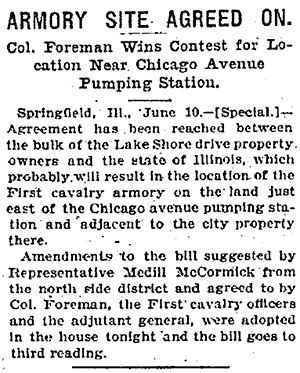
Chicago Daily Tribune, February 22, 1917
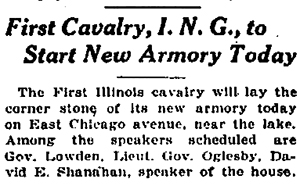
Chicago Daily Tribune, February 23, 1917
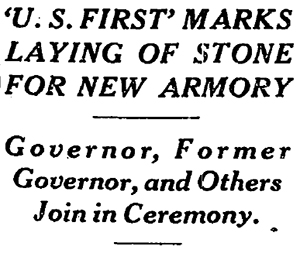 |
Chicago Daily Tribune, May 30, 1916
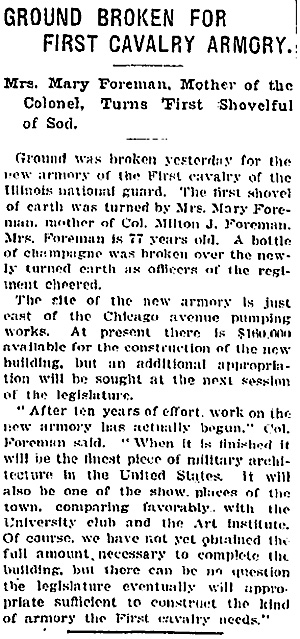
1916 Chicago Commerce, Volume 12, p. 75
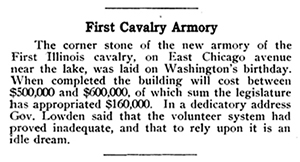
|







